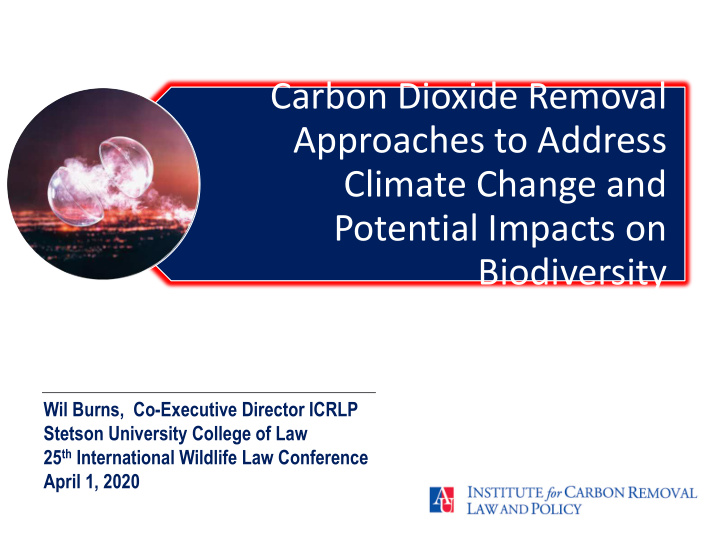



Carbon Dioxide Removal Approaches to Address Climate Change and Potential Impacts on Biodiversity Wil Burns, Co-Executive Director ICRLP Stetson University College of Law 25 th International Wildlife Law Conference April 1, 2020
2
Carbon Dioxide Removal Options Options that aim to remove carbon dioxide from the atmosphere and sequester or utilize it, directly countering the greenhouse effect. 3
The Exigency of Negative Emissions? 4
Overshoot Scenarios and NETS 5
6
Planktonic Collage: What Plankton Species Might Ocean Iron Fertilization Favor? 7
London Dumping Convention (1972) RESOLUTION LC-LP.1(2008) ON THE REGULATION OF OCEAN FERTILIZATION 3. AGREE that in order to provide for legitimate scientific research, such research should be regarded as placement of matter for a purpose other than the mere disposal thereof under Article III.1(b)(ii) of the London Convention and Article 1.4.2.2 of the London Protocol; 4. AGREE that scientific research proposals should be assessed on a case-by-case basis using an assessment framework to be developed by the Scientific Groups under the London Convention and Protocol . . . 8. AGREE that, given the present state of knowledge, ocean fertilization activities other than legitimate scientific research should not be allowed. To this end, such other activities should be considered as contrary to the aims of the Convention and Protocol and not currently qualify for any exemption from the definition of dumping in Article III.1(b) of the Convention and Article 1.4.2 of the Protocol; [emphasis added] 8
London Dumping Convention (1972) ASSESSMENT FRAMEWORK FOR SCIENTIFIC RESEARCH INVOLVING OCEAN FERTILIZATION (2010) Elements of environmental assessment: § Problem formulation § Site selection and description § Exposure assessment § Effects assessment § Risk Characterization § Risk Management § Decision Making § Results of Monitoring 9
London Protocol (1996) Resolution LP.4(8), Annex 4 (2013) Article 6bis 1. Contracting Parties shall not allow the placement of matter into the sea from vessels, aircrafts, platforms or other man-made structures at sea for marine geoengineering activities listed in Annex 4, unless the listing provides that the activity or the subcategory of an activity may be authorized under a permit … Annex 5: Assessment Framework for Matter that May be Considered for Placement Under Annex 4. [emphasis added] 10
CBD, 10 th COP 10 (2010) (w) Ensure . . . in the absence of science based, global, transparent and effective control and regulatory mechanisms for geo- engineering . . . that no climate-related geo-engineering activities that may affect biodiversity take place: “until there is an adequate scientific basis on which to justify such activities § and appropriate consideration of the associated risks for the environment and biodiversity and associated social, economic and cultural impacts;” “with the exception of small scale scientific research studies that would be § conducted in a controlled setting in accordance with Article 3 of the Convention;” “and only if they are justified by the need to gather specific scientific data § “and are subject to a thorough prior assessment of the potential impacts on § the environment; “[emphasis added] 11
Paris Agreement (2015) Preamble Recognizing that Parties may be affected not only by climate change, but also by the impacts of the measures taken in response to it, … 12
Paris Agreement (2015) Preamble Noting the importance of ensuring the integrity of all ecosystems, including oceans, and the protection of biodiversity, recognized by some cultures as Mother Earth . . . [emphasis added] 13
Recommend
More recommend